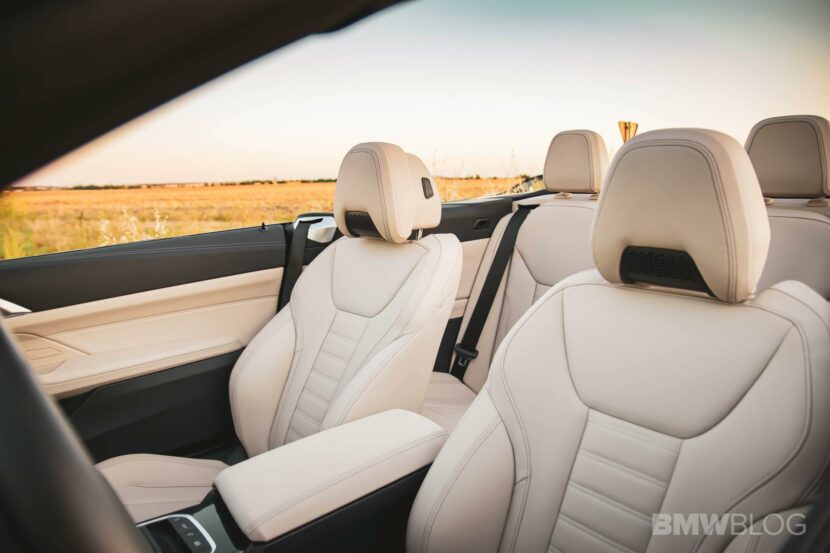TEST DRIVE: 2021 BMW 4 Series Convertible – Looking Past The Kidney Grille
The motion the roof goes through when you open or close it is different too. Now, the whole thing creates a ‘Z’ shape when folding, stacking the three main pieces of the roof one on top of the other and neatly folding them in the back. The whole process takes around 18 seconds, according to BMW, and you can do it at speeds up to 50 km/h (31 mph) which is an improvement over the last generation 4 Series. Of course, just like it was the case on the old one too, the windows are automatically raised when the process is done.
On top of the 40 percent weight reduction, the new roof also takes up less space in the boot. Therefore, you now have access to 300 liters of space in the boot, 80 more than in the previous-generation model. That may sound like an impressive upgrade but, it’s worth mentioning that the opening of the boot is rather small. If you’re planning on carrying stuff in there, you might want to make sure it will fit under the allotted space for the roof.
However, one interesting trick BMW implemented, is the possibility of adjusting the soft top compartment’s flap. This way, when the roof is up, you can gain access to up to 385 liters in total. As standard, you get a ski hatch in between the rear seats, in case you want to go skiing or maybe carry longer items.
Another novelty for the 4 Series convertible is the possibility of configuring it with two different color choices for the textile roof. You can go with a classic black finish or you can have it with an Anthracite Silver effect finish which does look pretty sharp.
Technically A 4-Seater, Practically For Two People

Inside the cabin there aren’t many differences compared to a regular Coupe model. Everything seems exactly the same up front but you will notice the lack of a B-pillar, which creates a sensation of space when sitting in the car. It also makes getting in the back a lot easier, as you can roll down the windows to help passengers out. However, there is a noticeably smaller and more cramped feeling in the back.
Theoretically, the 4 Series convertible is a four-seater but the rear seats would only work for… smaller humans. Their seatbacks are also a bit more upright, making longer journeys a bit tedious. Furthermore, the same old wind deflector solution was deployed by BMW for the new 4 Series drop top and that’s a bit disappointing.
While other car makers have created new solutions for this issue, BMW is sticking with a design that hasn’t changed a lot since it was first introduced on the E30 3 Series cabriolet. It’s the same two-piece mesh that gets fixed over the rear seats and basically nullifies them. Therefore, if you want to go on a longer trip, at higher speeds, you’ll have to choose: personal comfort or taking up to three people with you.

And that wind deflector truly makes a difference. Using it makes driving the 4 Series convertible rather comfy, without too much turbulence at speeds up to 110 km/h (68 mph) but if you remove it, you’ll notice that same threshold drops to about 80 km/h (50 mph). Raising the side windows will also help out a bit in this regard.
As it is always the case, if you also want to enjoy some great tunes on the way, you should probably go for the Harman Kardon top tier sound system available on the 4 Series convertible. I will point out that the hi-fi system we had on our tester delivered very good sound and it was rather impressive overall. It covered a wide range of frequencies and had a warm sound to it. Its only issue was the volume, but I guess that’s why you get the Harman Kardon alternative.
Different Driving Experience Than The Coupe?

On the road, the 4 Series convertible feels a lot like its coupe brother. Some things have changed, as you would expect. Just like it is the case with any drop top, the body of the car had to be reinforced, to cope without a very important structural piece: its roof.
The extra bracing wasn’t just aimed at increasing the body’s rigidity but also the suspension. To this end, an additional pair of struts was installed for reinforcing the car’s rear. Other model specific features for the convertible include side skirts with extreme torsional rigidity, a double heel board, an aluminum shear panel low down in the front end, a reinforced transmission tunnel in the rear compartment and a likewise extremely rigid floor plate at the rear. As a result, static torsional rigidity of the new BMW 4 Series Convertible is up by four percent overall compared to its predecessor.






